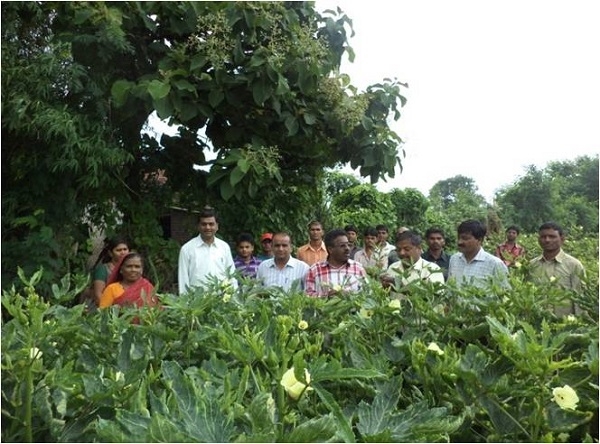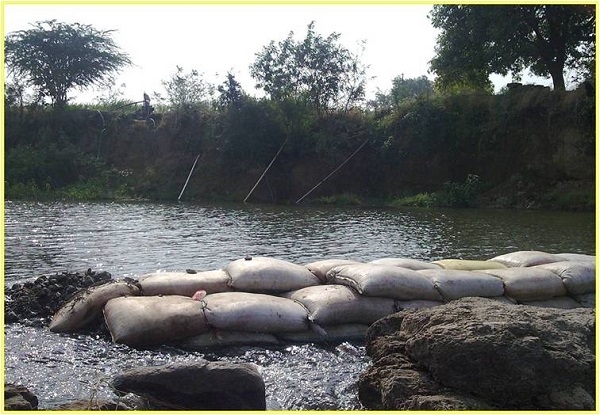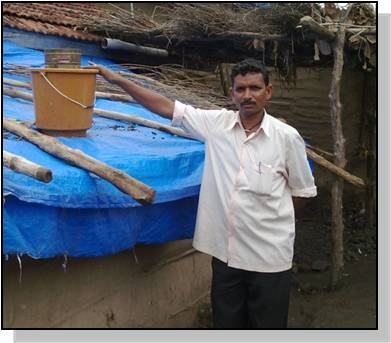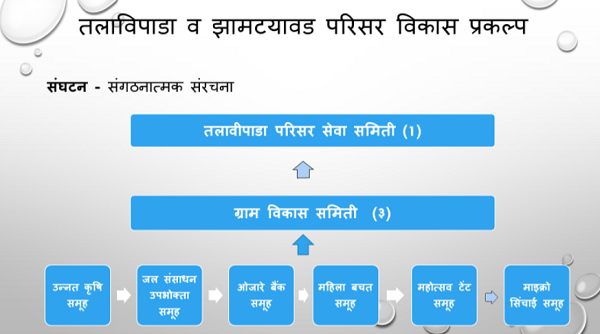Institutionalizing Local Development: Formalizing Antyodaya in Society
Total Views |
It was a dark day of January 2014 for some villages of Navapur tehsil, Nandurbar. For the first time, they experienced a hailstorm. This became a nightmare for farmers who started rabbi cultivation in the last 3-4 years. The entire crop of 8 villages near Khandbara was buried under hails. This unfortunate incident was then repeated in different parts of Maharashtra for next two months. Ironically, the government decided to provide support for February-March incident.
Government collects rainfall data only at tehsil level! Hailstorm was not experienced at tehsil level, so the government did not have a record for the same. Farmers decided to share their experiences with the government through their organization ‘Nesu Parisar Seva Samiti’. This samiti was set up by farmers few years back to promote appropriate development activities in their cluster. Armed with local data of rainfall, photographs and newspaper articles, farmers visited District Collector and other officials. Government officials were amazed with their preparations. Government amended their decision and incorporated areas where hailstorm occurred in January 2014. It was a major relief! Farmers who participated in mango wadi programme of NABARD raised funds and revived their one-year old mango orchards. The incident helped to cement confidence about the necessity of people’s institutions and its role in the current development process in their area.
As a development practitioner who travels across India, this was something rare for me. I visited these villages in April 2014. Just before that, I was in Dang - a nearby district. While walking in the village, I saw a broken pipe on the road. Wheat farms nearby were dried. I enquired about dry farms with a farmer I understood from him that, government vehicle broke the pipe and they are waiting for the government to repair the same. Locals were not ready to fix 10 ft plastic pipe. They want the government to do it. It is just not an issue of pipe or amount; it shows society has changed over the last few decades and completely depends on the government to fix anything. It is an issue of a changed mind set. This mind set is a result of British era and development policies adopted after independence. India has a rich heritage of community ownership and community-based development. Community led Water harvesting and distribution practices are present all over India. They were evolved in a few centuries and governed by people. Similarly, we had systems to protect the environment, forest and manage disputes etc. But this has changed in last 200 years. From self-reliant, community governed society; we shifted to government led society. Our society has walked a long way on this path. We became ST passengers. One, who enters the bus, takes a ticket, sits down, sleeps, and reads the paper. It is now a duty of the conductor to get him up on the stop which he wants to get down. If a conductor misses, it becomes conductors’ fault and not the passenger’s. And we all know what happens after that.
Indian development Philosophy does not advocate this behavior. Pandit Deendayal Upadhyay in his ‘Ekatma Manav Darshan’ had discussed what is expected from society and government in the development process. He said, Community should steer the development process and all others including the government should support and facilitate the process. But today the government has become a driver and conductor of our development bus and the community has become passengers. People who want to develop are dependent on the government and are just doing what government says. No one thinks if this is the right path or do we have some better alternative? Will this impact our living style, our culture? Is this suitable for our working style, our local environment? But what does this community steering development process actually mean on the ground?

Nesu river is a small tributary of tapi and flows in navapur tehsil. Small villages are settled for ages on banks of Nesu. Khandbara is a market village for them. Average rainfall in this area is around 1000 mm. As there is no work after monsoon season, most people used to migrate to Surat from this area. In 2007, Dr. Hedgewar Seva Samiti started interacting with 8 villages about their condition. People started discussing possible actions. Samiti proposed a small action to set up cement bang dams and provided bags. 17 small cement Bag dams or Vanrai dams were constructed by people. Soon people realized that this small action has resulted in good water storage which they can actually use for irrigation. At this juncture, Samiti introduced ‘Group Sharing’ of lifting devices. The idea is to use one lifting device by a group of 4-5 farmers. Initially there was some resistance but soon people realize that through this way most of them can use the water. They formed water use groups and collected contributions for repairing and other costs. It took 3-4 years to stabilize this process. For the first time, many of them cultivated their land in rabbi season. Government realized the potential and decided to construct cement dams. Till that time people organized themselves into ‘Nesu Parisar Seva Samiti’. They demanded that site selection will be jointly conducted and finalized. Also, samiti will supervise work and labourers should be from the same villages. This has resulted in appropriate site selection and quality work. In 2020, more than 1800 acres of area is under irrigation. This was linked with integrated crop and water management. Also niche farming like seed production, group vegetable production, mixed farming for home food security, horticulture, agriculture processing and allied enterprises were introduced in collaboration with Krishi Vigyan Kendra, Nandurbar. 800 families are benefited due to this. Migration from these villagers has almost stopped.

This is a real time example of community steering development process. Local community took pilot actions with help of voluntary organization. Pilot was successful and people were benefited. Community formed a people’s institution. For 5-6 years people tried hard to come together, share experiences, take decisions, and were part of profits and loss. After a lot of churning, institutions were built and nurtured over the period. Then these institutions worked with government for upscaling efforts and enhanced benefits. They even negotiated with the government for an appropriate development process and in a calamity situation.

Different kinds of institutions as per need were formed. Resource based farmers groups were formed. They undertook all on ground activities like group vegetable farming, seed production, water use groups etc. At village level, a Gram Vikas Samiti was formed for coordination and formal linkage with government and other institutions. This samiti identified farmers for specific activities, took responsibility for activity implementation, kept records and distributed resources etc. Parisar Seva Samiti was formed for 8 villages. This was something which links to our traditional system of Panchakroshi and some institutions in tribal areas. Natural ecosystems are beyond boundaries of administrative systems. People’s livelihood is dependent on natural resources. So, it’s imperative that natural resource-based decision systems are required for smooth functioning of the development process. Like Nesu samiti, other Parisar Samitis are bring formed and activated in the area. One such samiti Talavipada Parisar Seva Samiti is steering process on upper side of Nesu river.
Parisar Seva Samiti is based on a natural resource system and does not have revenue boundaries. They formed their rules and identified limitations. They decided to keep away politicians from taluka and above level from samiti’s decision making process. So, while elections were fought on banner of different parties, decisions for agriculture, water use etc was taken involving all. Parisar Seva samiti took lead in setting up village and resource systems, resolving disputes, keeping politics away, negotiating with the government and other agencies. They act like focal point. One can cite many examples where their institutions played a crucial role. All these farmer club and Parisar Seva Samiti people are working as volunteers and acting like agents of change.

Apart from group-based institutions, some individual efforts are encouraged and supported by samiti. Jaldoot is one such effort. A volunteer is identified to record rainfall in village. Small rainfall measurement units were setup. Volunteer is chosen by the farmer club. Volunteer undertakes this activity as Seva. Records kept by these volunteers were crucial when villagers approached the government for support after hailstorm. Considering these efforts and importance of data, Ground water department has given calibrated rain gauge in these villages and linked the data to their database. Samiti is also providing support to form economic institutions like farmer producer company and enterprise groups for commercial activities.
Seva aspect of these institutions is unique in institutional development. It is necessary for development process, along with benefits people are also willing to give back to society. One needs to imbibe this into institutions. It is much beyond providing Shramdaan and monetary contribution in the project. Taking up responsibility and time commitment for community work is necessary and that should come across seva or one can say by willingness. This aspect was covered in the above process.
In the formal three-tier governance system, the last tier, Gram Panchayat is more into governance and administrative activities. Practically we do not have a specific system for development after taluka except few appointed employees. Government machinery for development has its own limitation viz. funds, human resource, and technology support apart from implementation of all other non-development work. A parallel but voluntary system for development is necessary. Above is one such example. Multiple agencies are working on this across India. NGOs across the nation should facilitate formation of people's organization to steer development process in the country. Ekatma manav darshan advocated formation of self-reliant people’s institutions. These institutions work for people, run by people, and are managed by people. At the same time, they work independently from government and general people sentiment and take decisions for the benefit of every member of the community. Concept of Antyodaya envisaged by Indian Development Philosophy expected such institutions to represent the community in development paradigm.
(English language input from Pradnya Joglekar)

